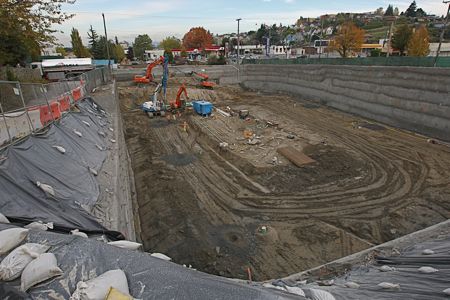
(October 2008 photo by WSB contributing photojournalist Christopher Boffoli)
Driving by the Fauntleroy Place (Whole Foods) project daily, we started pondering a goofy little question once major excavation began: When you dig a big hole like that, what happens to the dirt? Since we (and other small news organizations around Puget Sound) work with the student journalists at the University of Washington News Lab, we offered them the assignment. Read on, to see how the answer turned out to be not as simple as you might think:
By Madelyn Fairbanks
UW News Lab
We all become scientists when we absentmindedly wonder about our surroundings. Take the law of displacement — for example, the Fauntleroy Place excavation. Where does all that dirt go?
According to Eric Radovich, spokesperson for development firm BlueStar, the company subcontracted with Aero Construction, whose trucks ran up to 300 truckloads of dirt a day during the excavation.
They recently finished digging, Radovich said, after having hauled more than 100,000 cubic yards of dirt out of the gaping hole at 39th Avenue Southwest and Southwest Alaska Street.

(WSB photo from earlier in the excavation, September 2008)
Dan McTaggart, a development manager for BlueStar, said the trucks were heading south to the city of Sumner, and as far as he’s concerned, they can do with it what they want.
It’s “good dirt,” said McTaggart, explaining that it is dense, compacts well, and has a high level of sand, and it is of good value to actually be sold. This is unlike a previous project that yielded mostly clay-dense dirt, which, McTaggart said, is mostly useless.
Lee Anderson, the Parks/Facilities manager for the city of Sumner, wondered if there might not have been a better use for it closer to Seattle. “That’s a lot of wear and tear on the roads,” said Anderson, who added that he likes to be green-minded in his job at Sumner.
Radovich of BlueStar said that to his knowledge, the dirt was being used to fill up an “old gravel pit in Sumner” for a new park. Anderson couldn’t confirm any plans for any parks in Sumner. It’s possible that they’re depositing the dirt somewhere in the area, Anderson said, and the Community Development department at Sumner would be the people who would know where it was going. However, calls to the Community Development department were not returned.
The company that ran the trucks, Aero Construction, declined to give specific information as to where the dirt was going. A woman who preferred to go unnamed said that “it’s a challenge finding homes for dirt,” and that the Fauntleroy Place dirt has gone “here and there.” Aero’s PR representative did not return phone-call requests.
Regardless of where the dirt ended up, construction moves along. The excavation is making space for a four-level parking garage with more than 500 spaces; of those, about half will be for Whole Foods customers specifically. In addition to Whole Foods, Fauntleroy Place will house a new Hancock Fabrics store, with close to 200 apartments over the retail spaces. BlueStar expects the development to be complete in early 2010.
===========
MADELYN FAIRBANKS is a student in the University of Washington Department of Communication News Laboratory.

| 22 COMMENTS